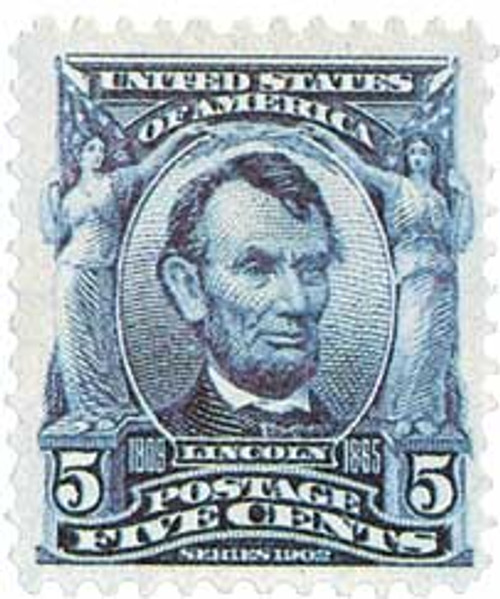
# 313 - 1903 $5 Marshall, dark green
Series of 1902-03 $5 Marshall
Quantity issued: 49,211
Printed by: Bureau of Engraving and Printing
Method: Flat plate
Watermark: Double line
Perforation: 12
Color: Dark green
John Marshall – Longest-Serving Chief Justice
The eldest of fifteen children, John Marshall was born in a log cabin near Germantown, Virginia. Marshall joined the Continental Army in 1776, and spent the winter of 1777-78 at Valley Forge with General George Washington’s forces. He was promoted to captain in 1778. Although he had little formal education, Marshall studied law at the College of William and Mary and was admitted to the Virginia bar in 1780. He quickly established a career defending individuals against their pre-Revolutionary War British debtors.

Marshall served several terms of office in Virginia’s House of Delegates. As a delegate to the constitutional convention, Marshall spoke forcefully in favor of a new constitution to replace the weak Articles of Confederation. After declining several positions in the Washington and Adams administrations, Marshall served briefly in the U.S. House of Representatives and as President Adam’s Secretary of State. Marshall was appointed Chief Justice of the Supreme Court in 1800. The Senate confirmed his appointment on January 27, 1801, and he was sworn in on January 31, officially taking office on February 4. Marshall continued to serve as secretary of state as well until Adams’ term was completed one month later.
Marshall believed that the Constitution was the supreme law of the land. As such, any law enacted by a branch of government must adhere to its principles or be struck down as unconstitutional. The Supreme Court’s landmark decision in Marbury vs. Madison, which determined that an action by a public official violated another’s constitutional rights, reflected this concept of judicial review. Judicial review, which is the practice of reviewing actions of government branches, firmly established the Supreme Court’s powers.

As chief justice of the U.S. Supreme Court for 34 years, Marshall participated in more than 1,000 decisions and authored more than 500 opinions. The legacy of the Marshall Court was an increase in the power of the Supreme Court as a branch of the Federal Government. It placed an emphasis on the role of the judiciary in states and led to a stronger Federal Government.
As a close friend of George Washington, Marshall announced his 1799 death, offered the eulogy at his funeral, and led the commission that planned the Washington Monument. At the request of Washington’s family, Marshall wrote a five-volume biography about our nation’s first President, The Life of George Washington. John Marshall died in 1835, ending the longest tenure of any Chief Justice in Supreme Court history.
Series of 1902-03 $5 Marshall
Quantity issued: 49,211
Printed by: Bureau of Engraving and Printing
Method: Flat plate
Watermark: Double line
Perforation: 12
Color: Dark green
John Marshall – Longest-Serving Chief Justice
The eldest of fifteen children, John Marshall was born in a log cabin near Germantown, Virginia. Marshall joined the Continental Army in 1776, and spent the winter of 1777-78 at Valley Forge with General George Washington’s forces. He was promoted to captain in 1778. Although he had little formal education, Marshall studied law at the College of William and Mary and was admitted to the Virginia bar in 1780. He quickly established a career defending individuals against their pre-Revolutionary War British debtors.

Marshall served several terms of office in Virginia’s House of Delegates. As a delegate to the constitutional convention, Marshall spoke forcefully in favor of a new constitution to replace the weak Articles of Confederation. After declining several positions in the Washington and Adams administrations, Marshall served briefly in the U.S. House of Representatives and as President Adam’s Secretary of State. Marshall was appointed Chief Justice of the Supreme Court in 1800. The Senate confirmed his appointment on January 27, 1801, and he was sworn in on January 31, officially taking office on February 4. Marshall continued to serve as secretary of state as well until Adams’ term was completed one month later.
Marshall believed that the Constitution was the supreme law of the land. As such, any law enacted by a branch of government must adhere to its principles or be struck down as unconstitutional. The Supreme Court’s landmark decision in Marbury vs. Madison, which determined that an action by a public official violated another’s constitutional rights, reflected this concept of judicial review. Judicial review, which is the practice of reviewing actions of government branches, firmly established the Supreme Court’s powers.

As chief justice of the U.S. Supreme Court for 34 years, Marshall participated in more than 1,000 decisions and authored more than 500 opinions. The legacy of the Marshall Court was an increase in the power of the Supreme Court as a branch of the Federal Government. It placed an emphasis on the role of the judiciary in states and led to a stronger Federal Government.
As a close friend of George Washington, Marshall announced his 1799 death, offered the eulogy at his funeral, and led the commission that planned the Washington Monument. At the request of Washington’s family, Marshall wrote a five-volume biography about our nation’s first President, The Life of George Washington. John Marshall died in 1835, ending the longest tenure of any Chief Justice in Supreme Court history.


















